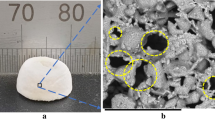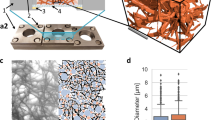Abstract
Image analysis has gained new effort in the scientific community due to the chance of investigating morphological properties of three dimensional structures starting from their bi-dimensional gray-scale representation. Such ability makes it particularly interesting for tissue engineering (TE) purposes. Indeed, the capability of obtaining and interpreting images of tissue scaffolds, extracting morphological and structural information, is essential to the characterization and design of engineered porous systems. In this work, the traditional image analysis approach has been coupled with a probabilistic based percolation method to outline a general procedure for analysing tissue scaffold SEM micrographs. To this aim a case study constituted by PCL multi-scaled porous scaffolds was adopted. Moreover, the resulting data were compared with the outputs of conventionally used techniques, such as mercury intrusion porosimetry. Results indicate that image processing methods well fit the porosity features of PCL scaffolds, overcoming the limits of the more invasive porosimetry techniques. Also the cut off resolution of such IP methods was discussed. Moreover, the fractal dimension of percolating clusters, within the pore populations, was addressed as a good indication of the interconnection degree of PCL bi-modal scaffolds. Such findings represent (i) the bases for a novel approach complementary to the conventional experimental procedure used for the morphological analysis of TE scaffolds, in particular offering a valid method for the analysis of soft materials (i.e., gels); also (ii) providing a new perspective for further studies integrating to the structural and morphological data, fluid-dynamics and transport properties modelling.






Similar content being viewed by others
References
Costa MFM. Application of image processing to the characterization of nanostructures. Rev Adv Mater Sci. 2004;6:12–20.
Coker DA, Torquato S, Dunsmuir JH. Morphology and physical rpoperties of Fontainebleu sand stone via a tomographic analysis. J Geophys Res. 1996;101:17497–506.
Lindquist WB, Lee SM, Coker DA, Jones KW, Spanne P. Medial axis analysis of void structure in three dimensional tomographic images of porous media. J Geophys Res. 1996;101(B4):8297–310.
Proussevitch AA, Sahagien DL. Recognition and separation of discrete objects within complex 3D voxalized structures. Comput Geosci. 2001;27(4):441–54.
Jones AC, Milthorpe B, Averdunk H, Limaye A, Senden TJ, Sakellariou A, Sheppard AP, Sok RM, Knackstedt MA, Brandwood A, Rohner D, Hutmacher DW. Analysis of D bone ingrowth into polymer scaffolds via micro-computed tomography imaging. Biomaterials. 2004;25(20):4947–54.
Moore MJ, Jabbari E, Ritman EL, Lu L, Cumer BL, Widebank AJ, Yoszemki MJ. Quantitative analysis of interconnectivity of porous biodegradable scaffolds with microcomputed tomography. J Biomed Mater Res. 2004;71A:258–67.
Cartmel S, Huynh K, Lin A, Nagaraja S, Guldberg R. Quantitative microcomputed tomography of mineralization within three-dimensional scaffolds in vitro. J Biomed Mater Res. 2004;69A(1):97–104.
Brumke O, Odenbach S, Beckman F. Quantitative methods for the analysis of syncroton- CT data sets of metallic foams. Eur Phys J Appl Phys. 2005;29(1):73–82.
Cooper DML, Turinky AL, Sensen CW, Hellgrimsson B. Quantitative 3D analysis of the canal network in cortical bone by micro-computed tomography. Anat Rec. 2003;274B:169–79.
Darling AL, Sun W. 3D microtomographic characterization of precision extruded polycaprolactone scaffolds. J Biomed Mater Res. 2004;70B:311–7.
Otsuki B, Takemoto M, Fujibayashi S, Neo M, Kokubo T, Nakamura T. Pore throat size and connectivity determine bone and tissue ingrowth into porous implants: three-dimensional micro-CT based structural analysis of porous bioactive titanium implants. Biomaterials. 2006;27:5892–900.
Rüegsegger P, Koller B, Muller R. A microtomographic system for the nanostructure evaluation of bone architecture. Calcif Tissue Int. 1996;58(1):24–9.
Hildebrandt T, Rüegsegger P. Quantification of bone microarchitecture with the Structure Model Index. Comput Methods Biomech Biomed Eng. 1997;1:15–23.
Van Lenthe GH, Hagenmüller H, Bohner M, Hollister SJ, Meinel L, Müller R. Nondestructive micro-computed tomography for biological imaging and quantification of scaffold–bone interaction in vivo. Biomaterials. 2007;28(15):2479–90.
Rajagopalan S, Lu L, Yaszemski MJ, Robb RA. Optimal segmentation of microcomputed tomographic images of porous tissue-engineering scaffolds. J Biomed Mater Res A. 2005;75:877–87.
Oh SH, Park IK, Kim JM, Lee JH. In vitro and in vivo characteristics of PCL scaffolds with pore size gradient fabrication by a centrifugation method. Biomaterials. 2007;28:1404–13.
Moquet V, Bòacher S, Pirard R, Pirard JP, Jerome R. Characterization of porous polylactide foams by image analysis and impedance spectroscopy. Langmuir. 2000;16:10463–70.
Grant PV, Voz CM, Tomlins PE, Mikvalovska L, Jones S, Mikalovsky S, Vadgama P. Surface chemistry in biomedical and environmental science part 2. The Netherlands: Springer; 2006. pp. 215–28.
Winslow DN. Advances in experimental techniques for mercury intrusion porosimetry. In: Matjevic E, Good RJ, editors. Surface and colloid science. New York: Plenum Press; 1984. p. 259–82.
Zein I, Hutmacher DW, Tan KC, Teoh SH. Fused deposition modeling of novel scaffold architectures for tissue engineering applications. Biomaterials. 2002;23(4):169–85.
Li CT. Multiresolution image segmentation integrating Gibbs sampler and region merging algorithm. Signal Process. 2003;83(1):67–78.
Mather ML, Morgan SP, White LJ, Tai H, Kockenberg W, Crowe JA. Image-based characterization of foamed polymeric tissue scaffolds. Biomed Mater. 2008;3:1–11.
Malpica N, Solorzano C, Vaquero J, Santos A, Vallcorba I, Garcia-Sagredo J, F Pozo. A multichannel watershed-based algorithm for supervise texture segmentation. Cytometry. 1997;28:289–97.
Sijbers J, Verhoye M, Scheunders A, Van der Linden A, Van Dyck D, Raman E. Watershed-based segmentation of 3D MR data for volume quantification. Magn Reson Imaging. 1997;15(6):679–88.
Cates JE, Whitaker RT, Jones GM. Case study: an evaluation of user-assisted hierarchical watershed segmentation. Med Image Anal. 2005;9(6):566–78.
Sezgin M, Sankur B. Survey over image thresholding techniques and quantitative performance evaluation. J Electron Imaging. 2004;13(1):146–65.
Whang K, Thomas CK, Nuber G, Heoly KE. A novel method to fabricate bioresorbable scaffolds. Polymers. 1995;36:837.
Heoly KE, Tsai D, Kim JE. Osteogenic cell attachment to degradable polymers. Mater Res Soc Symp Proc. 1992;252:109–14.
Murphy WL, Dennis RG, Kileny JL, Mooney DJ. Salt fusion: an approach to improve pore interconnectivity within tissue engineering scaffolds. Tissue Eng. 2002;8(1):43–52.
Mathieu LM, Mueller TL, Bourban PE, Pioletti DP, Müller R, Månson JAE. Architecture and properties of anisotropic polymer composite scaffolds for bone tissue engineering. Biomaterials. 2006;27(6):905–16.
Guarino V, Taddei P, Di Foggia M, Fagnano C, Ciapetti G, Ambrosio L. Influence of hydroxyapatite particles on in vitro degradation behaviour of poly ε-caprolactone-based composite scaffolds. Tissue Eng. 2009;15(11):3655–68.
Smith TG Jr, Lange GD, Marks WB. Fractal methods and results in cellular morphology. J Neurosci Methods. 1996;69:1123–26.
Schugens C, Maquet V, Grandfils C, Jerome R, Teyssie P. Biodegradable macroporous polylactide implants for cell transplantation: I. Preparation of polylactide foams by solid-liquid phase separation. Polymer. 1996;37:1027–38.
Salerno A, Guarnieri D, Iannone M, Zeppetelli S, Di Maio E, Iannace S, Netti PA. Engineered l-bimodal poly(e-caprolactone) porous scaffold for enhanced hMSC colonization and proliferation. Acta Biomater. 2009;5(4):1082–93.
Guarino V, Causa F, Ambrosio L. Porosity and mechanical properties relationship in PCL based scaffolds. J Appl Biomater Biomech. 2007;5(3):149–57.
Ho ST, Hutmacher DW. A comparison of micro-CT with other techniques used in the characterization of scaffolds. Biomaterials. 2006;27:1362–76.
Guarino V, Causa F, Netti PA, Ciapetti G, Pagani S, Martini D, Baldini N, Ambrosio L. The role of hydroxyapatite as solid signals on performance of PCL porous scaffolds for bone tissue re generation. J Biomed Mat Res Appl Biomater. 2008;86B:548–57.
Srinivasan R, Lu L, Yaszemski MJ, Robb RA. Optimal segmentation of microcomputed tomographic images of porous tissue-engineering scaffolds. J Biomed Mater Res A. 2005;75(4):877–87.
Reed AH, Briggs KB, Lavoie DL. Porometric properties of a siliciclastic marine sand: a comparison of traditional laboratory measurements with image analysis and effective medium theory modelling. IEEE J Ocean Eng. 2002;27:581–92.
Ehrlich R, Kennedy SK, Crabtree SJ, Cannon RL. Petrographic image analysis I. Analysis of reservoir pore complexes. J Sediment Pet. 1984;54:1365–78.
White JV, Kirkland BL, Gournay JP. Quantitative porosity determination of thin sections using digitized images. J Sediment Res. 1998;68:220–2.
Reed AH, Pandey RB, Lavoie DL. Fractal dimensionality of pore and grain volume of a siliciclastic marine sand. Int J Mod Phys C. 2000;11:1555–9.
Yamaguchi T, Hashimoto S. Image processing based on percolation model. IEICE Trans Inf Syst. 2006;E89-D(7):2044–52.
Hussain I, Reed TR. A bond percolation-based model for image segmentation. IEEE Trans Image Process. 1996;6(12):1698–704.
Craciunescu OI, Das SK, Clegg ST. Dynamic contrast-enhanced MRI and fractal characteristics of percolation clusters in two-dimensional tumor blood perfusion. Trans ASME J Biomech Eng. 1999;121:480–6.
Stauffer D, Aharony A. Introduction to percolation theory. Philadelphia: Taylor and Francis; 1994.
Mandelbrot BB. The fractal geometry of nature. San Francisco: CA Freeman; 1982. pp. 468–69.
Orford JD, Walley WB. The use of fractal dimension to quantify the morphology of irregular shaped particles. Sedimentology. 1983;30:655–68.
Oh W, Lindquist WB. Image thresholding by indicator kriging. IEEE Trans Pattern Anal Mach Intell. 1999;21(7):590–602.
Acknowledgments
This study was financially supported by the IP STEPS EC project, FP6-500465. The authors wish to acknowledge the support obtained from Italian Ministry of University and Research (TISSUENET) for this research. Moreover, they would also like to thank Mr. Maurizio Cotugno for its collaboration during its bachelor master thesis spent in the Institute of Composite and Biomedical Materials and Mr. Paolo Carboni for its support in the image reconstruction.
Author information
Authors and Affiliations
Corresponding authors
Rights and permissions
About this article
Cite this article
Guarino, V., Guaccio, A., Netti, P.A. et al. Image processing and fractal box counting: user-assisted method for multi-scale porous scaffold characterization. J Mater Sci: Mater Med 21, 3109–3118 (2010). https://doi.org/10.1007/s10856-010-4163-9
Received:
Accepted:
Published:
Issue Date:
DOI: https://doi.org/10.1007/s10856-010-4163-9




